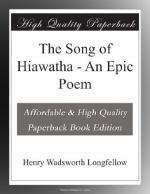|
This section contains 2,549 words (approx. 9 pages at 300 words per page) |

|
SOURCE: “Mars in Petticoats: Longfellow and Sentimental Masculinity,” in Nineteenth-Century Literature, Vol. 51, No. 3, December, 1996, pp. 327-55.
In the following excerpt, Haralson addresses the concepts of masculinity and femininity as Longfellow idealistically portrays them in The Song of Hiawatha.
For all of the signal contributions of Evangeline and the earlier lyric verse, the Longfellow work that intervened most decisively in the gender system and most subtly rewrote manhood was that “pastel jeremiad”—as Daniel Aaron calls it—The Song of Hiawatha.1 As Robert A. Ferguson has shown, Hiawatha centered on the sectional strife—inscribed as intertribal “wranglings and dissensions”—that imperiled the American union; and the patent trope of hoped-for reconciliation resided in Hiawatha's marriage to Minnehaha: “That our tribes might be united … And old wounds be healed forever.”2 A more ambitious goal of the narrative, according to Eric J. Sundquist, was retroactively “to sanctify the rise of a...
|
This section contains 2,549 words (approx. 9 pages at 300 words per page) |

|


